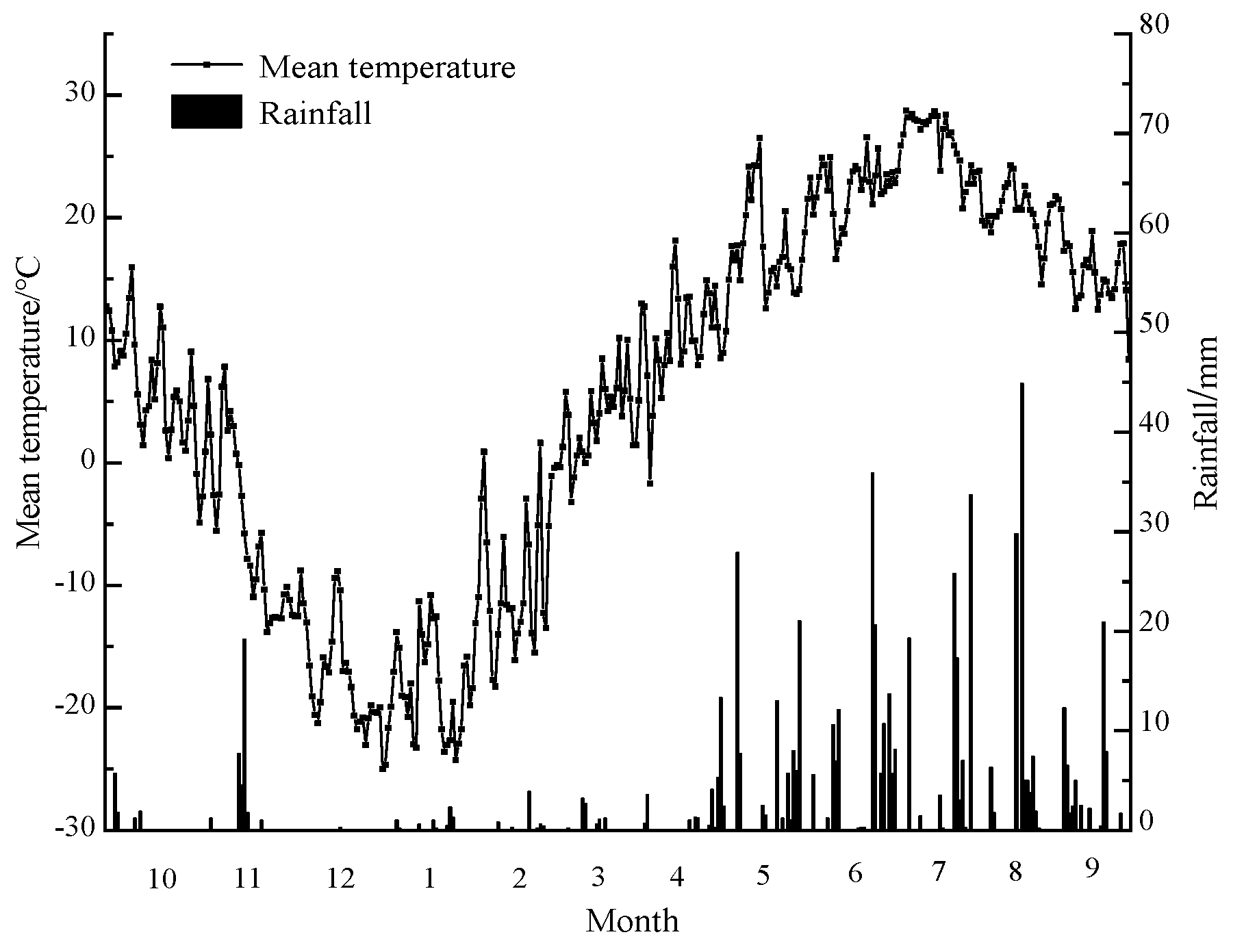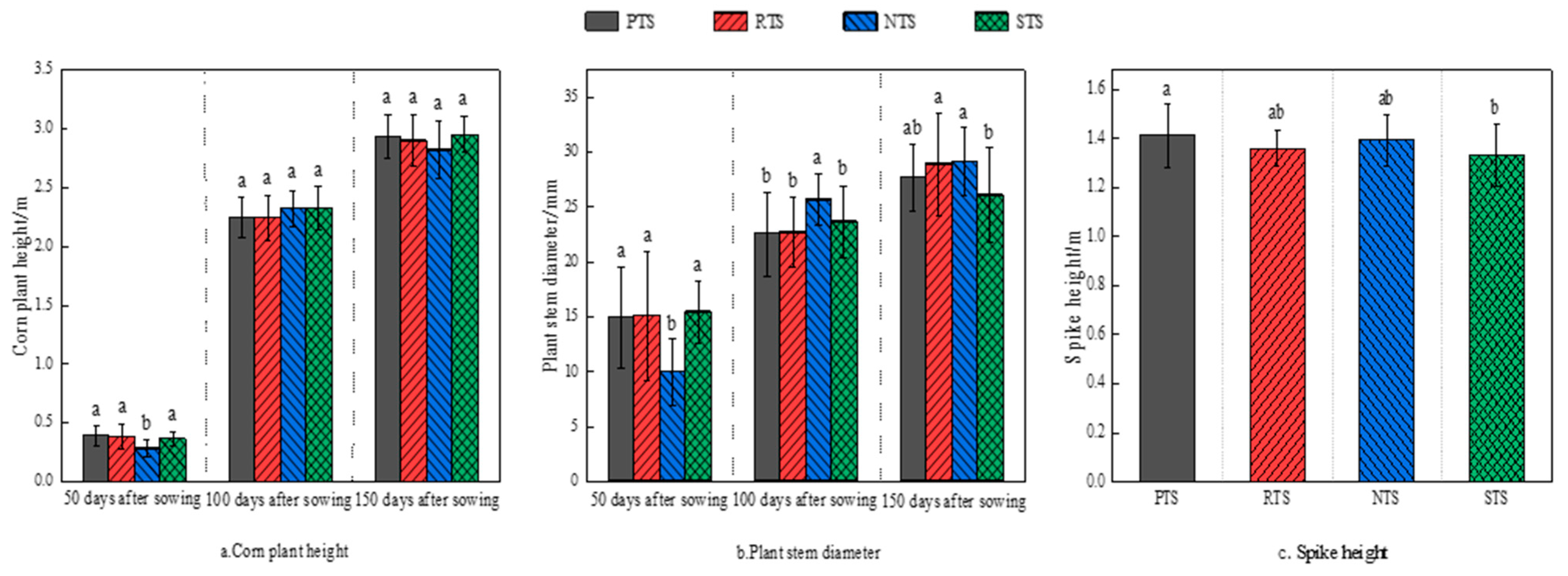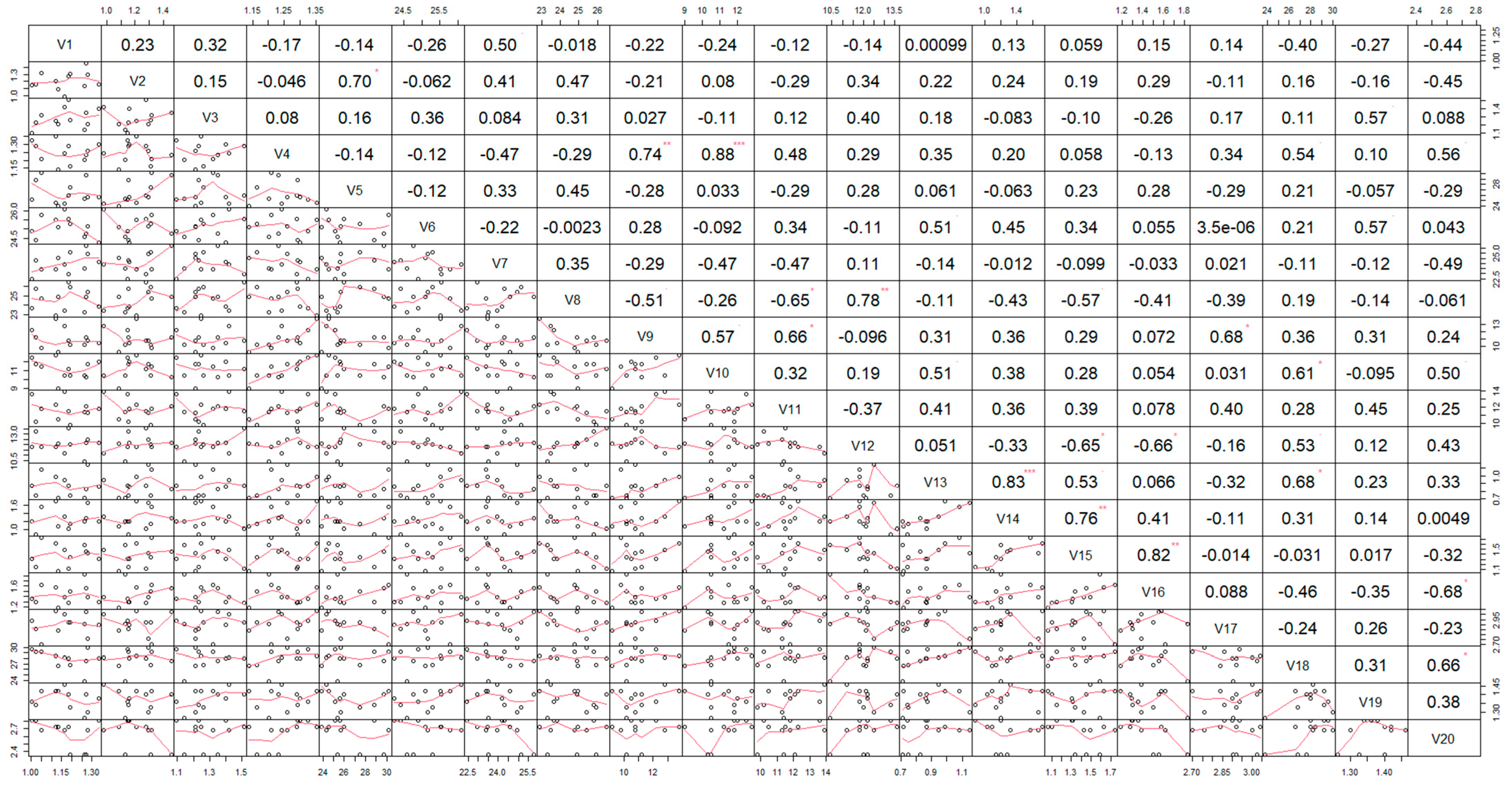Effects of Tillage and Sowing Methods on Soil Physical Properties and Corn Plant Characters
Abstract
:1. Introduction
2. Materials and Methods
2.1. Experimental Site
2.2. Experimental Design
2.3. Methods for Determination of Indicators and Analysis
2.3.1. Methods for Determination of Soil Physical Properties
2.3.2. Methods for Determination of Plant Growth Characters and Yield Components
2.3.3. Method for Determination of Corn Yield
2.4. Methods of Data Analyses
3. Results
3.1. Effects of Tillage and Sowing Methods on Soil Physical Properties
3.1.1. Effects of Tillage and Sowing Methods on SPR
3.1.2. Effects of Tillage and Sowing Methods on Soil Moisture Content and Temperature
3.1.3. Effects of Tillage and Sowing Methods on Soil Bulk Density
3.2. Effects of Tillage and Sowing Methods on Plant Characters and Yield
3.3. Correlation Analysis of Soil Physical Properties, Plant Characters, and Yield under Different Tillage and Sowing Methods
3.3.1. Correlation Analysis
3.3.2. Redundancy Analysis
4. Discussion
5. Conclusions
Author Contributions
Funding
Institutional Review Board Statement
Data Availability Statement
Conflicts of Interest
References
- Cong, H.B.; Meng, H.B.; Yu, J.D. Analysis of long-term mechanism for development of straw industry in northeast China under guidance of “Green-concept”. Trans. CSAE 2021, 37, 314–321. [Google Scholar] [CrossRef]
- Yan, L.; La, Y.P.; Dong, T.H. Soil physical properties and vertical distribution of root systems affected by tillage methods in black soil slope farmlands in Northeast China. Trans. CSAE 2021, 37, 125–132. [Google Scholar] [CrossRef]
- Zhang, X.Y.; Liu, X.B. Key issues of Mollisols research and soil erosion control strategies in China. Bull. Soil Water Conserv. 2020, 40, 340–344. [Google Scholar] [CrossRef]
- Chen, N.N.; Li, J.; Lv, W.; Wang, S.L. Effects of different rotational tillage patterns on soil physical properties and yield of winter wheat-spring maize rotation field in Weibei highland. Chin. J. Eco-Agric. 2015, 23, 1102–1111. [Google Scholar] [CrossRef]
- Li, N.; Long, J.H.; Han, X.Z.; Zhang, F.Q.; Lei, W.Y.; Sheng, M.; Han, Z.Y. Effects of short-term plowing and organic amendments on soil physical properties and maize yield in dark brown soil in Northeast China. Trans. CSAE 2021, 37, 99–107. [Google Scholar] [CrossRef]
- Misban, A.H.; Habtamu, M.; Petra, S.; Prossie, N.; Seifu, A.T.; Simon, L.; Jennie, B.; Tammo, S.S. Deep Tillage Improves Degraded Soils in the (Sub) Humid Ethiopian Highlands. Land 2019, 8, 159. [Google Scholar] [CrossRef] [Green Version]
- Dong, J.X.; Song, W.J.; Cong, P. Improving Farmland Soil Physical Properties by Rotary Tillage Combined with High Amount of Granulated Straw. Sci. Agric. Sin. 2021, 54, 2789–2803. [Google Scholar] [CrossRef]
- Zhu, M.; Shi, Y.X.; Sun, Z.Y.; Wang, X.L.; Zhang, D.; Kong, F.L.; Yuan, J.C. Effect of straw return and rotary tillage on soil physical properties and mechanical sowing quality of maize in Central Sichuan. Chin. J. Eco–Agric. 2017, 25, 1025–1033. [Google Scholar] [CrossRef]
- Catania, P.; Badalucco, L.; Laudicina, V.A.; Vallone, M. Effects of tilling methods on soil penetration resistance, organic carbon and water stable aggregates in a vineyard of semiarid Mediterranean environment. Environ. Earth Sci. 2018, 77, 348. [Google Scholar] [CrossRef]
- Blanco-Canqui, H.; Ruis, S.J. No-tillage and soil physical environment. Geoderma 2018, 326, 164–200. [Google Scholar] [CrossRef]
- Pittelkow, C.M.; Liang, X.; Linquist, B.A.; Groenigen, K.J.; Lee, J.; Lundy, M.E.; Gestel, N.; Six, J.; Venterea, R.T.; Kessel, C. Productivity limits and potentials of the principles of conservation agriculture. Nature 2015, 517, 365. [Google Scholar] [CrossRef] [PubMed]
- Lu, B.L.; Bao, X.G.; Che, Z.X.; Zhang, J.D.; Wu, K.S.; Yang, X.J. Effects of long-term no-tillage with crop stubbles on yield and stability of spring wheat in Hexi Oasis Irrigated Areas. Trans. CSAE 2022, 38, 117–126. [Google Scholar] [CrossRef]
- Kahlon, M.S.; Lal, R.; Ann-Varughese, M. Twenty two years of tillage and mulching impacts on soil physical characteristics and carbon sequestration in Central Ohio. Soil Tillage Res. 2013, 126, 151–158. [Google Scholar] [CrossRef]
- Gu, S.Y.; Zhu, Y.W.; Guo, X.J.; Cai, Y.T.; Wu, S.; Zhang, Z.H.; Zhang, H.H. Effects of Different Tillage Ways on Seedling Growth of Maize and Soil Physical Properties in Mollisol Region. Acta Agric. Boreali-Sin. 2018, 33, 226–231. [Google Scholar] [CrossRef]
- Zhao, H.B.; He, J.; Li, H.W.; Wang, Q.J.; Li, W.Y.; Liu, W.Z. Effect of Straw Returning Manners on Seedbed Soil Physical Properties and Winter Wheat Growth. Trans. Chin. Soc. Agric. Mach. 2018, 49, 60–67. [Google Scholar] [CrossRef]
- Orzech, K.; Wanic, M.; Zaluski, D. The Effects of Soil Compaction and Different Tillage Systems on the Bulk Density and Moisture Content of Soil and the Yields of Winter Oilseed Rape and Cereals. Agriculture 2021, 11, 666. [Google Scholar] [CrossRef]
- Linhares, A.; Gonalves, W.G.; Costa, K. Are the yield of sunflower and Paiaguas palisadegrass biomass influenced by soil physical quality? Soil Tillage Res. 2021, 208, 104873. [Google Scholar] [CrossRef]
- Yan, L.; Jiang, X.X.; Ji, X.N.; Zhou, L.; Li, S.Y.; Chen, C.; Li, P.; Zhu, Y.C.; Dong, T.H.; Meng, Q.F. Distribution of water-stable aggregates under soil tillage practices in a black soil hillslope cropland in Northeast China. J. Soils Sediments 2020, 20, 24–31. [Google Scholar] [CrossRef]
- Qiao, J.Y.; Zhang, D.; Zhang, H.B.; Zhang, B.; Chen, H.T.; Shen, L.P.; Zheng, D.M.; Sun, J. Effects of soil compaction by various tractors on soil penetration resistance and soybean yields. Trans. CSAE 2019, 35, 26–33. [Google Scholar] [CrossRef]
- Wang, Y.J. Soil Physical Properties and Effect Evaluation of Mechanized Tillage Planting Methods in Black Sloping Farmland. Ph.D. Thesis, Northeast Agricultural University, Harbin, China, 2021. [Google Scholar]
- NY/T52-1987; National Standards of the People’s Republic of China. Method for the Determination of soil Water Content. National Bureau of Standards: Beijing, China, 1987.
- Wang, Q.J.; Jiao, F.; Liu, F.; Chang, B.C.; Jiang, H.; Jiang, Y.; Mi, G.; Zhou, X. Effect of straw pulverization and concentrated deep-buried into field on growth and yield of maize. Trans. CSAE 2018, 34, 153–159. [Google Scholar] [CrossRef]
- You, S.T.; Deng, C.; Li, H.M.; Lv, M.; Li, Z.M.; Liu, H.F. QTL Mapping of Plant Height and Ear Height in Maize. J. Henan Agric. Sci. 2019, 48, 20–25. [Google Scholar] [CrossRef]
- GB5009.3—2016; State health and Family Planning Commission of the People’s Republic of China. Determination of moisture in Food. China Standards Press: Beijing, China, 2016.
- Canoco 5. Canoco for Visualization of Multivariate Data—WUR. Available online: https://www.wur.nl/en/show/Canoco-for-visualization-of-multivariate-data.htm#:~:text=Canoco%20is%20a%20software%20package,of%20the%20two%2C%20constrained%20ordination (accessed on 1 February 2022).
- Bogunovic, I.; Pereira, P.; Kisic, I.; Sajko, K.; Sraka, M. Tillage management impacts on soil compaction, erosion and crop yield in Stagnosols (Croatia). CATENA 2018, 160, 376–384. [Google Scholar] [CrossRef]
- Gao, W.; Whalley, W.R.; Tian, Z.; Liu, J.; Ren, T. A simple model to predict soil penetrometer resistance as a function of density, drying and depth in the field. Soil Tillage Res. 2016, 155, 190–198. [Google Scholar] [CrossRef]
- Wang, Y.K.; Zhang, Z.B.; Jiang, F.H.; Guo, Z.C.; Peng, X.H. Evaluating soil physical quality indicators of a Vertisol as affected by different tillage practices under wheat-maize system in the North China Plain. Soil Tillage Res. 2021, 209, 104970. [Google Scholar] [CrossRef]
- Burgos Hernández, T.D.; Slater, B.K.; Corbalá, R.T.; Shaffer, J.M. Assessment of long-term tillage practices on physical properties of two Ohio soils. Soil Tillage Res. 2019, 186, 270–279. [Google Scholar] [CrossRef]
- Yang, Y. Effcets of Different Tillage Measures on Soil Physical and Chemical Characters and Crop Yield in Cropland. Ph.D. Thesis, Northwest A&F University, Xianyang, China, 2017. [Google Scholar]
- Li, Y.J.; Wu, J.Z.; Huang, M.; Yao, Y.Q.; Zhang, C.J.; Cai, D.X.; Jin, K. Effects of different tillage systems on photosynthesis characteristics of flag leaf and water use efficiency in winter wheat. Trans. CSAE 2006, 22, 44–48. [Google Scholar]
- Mohanty, M.; Bandyopadhyay, K.K.; Painuli, D.K.; Ghosh, P.K.; Misra, A.K.; Hati, K.M. Water transmission characteristics of a Vertisol and water use efficiency of rainfed soybean (Glycine max (L.) Merr.) under subsoiling and manuring. Soil Tillage Res. 2007, 93, 420–428. [Google Scholar] [CrossRef]
- Lu, Y.L.; Zhang, M.; Liu, X.N.; Ren, T.S.; Wang, Y.J. Effects of soil water content and bulk density on thermal conductivity of plough layer soil in arid land and its prediction. Trans. CSAE 2018, 34, 146–151. [Google Scholar] [CrossRef]
- Yang, J.Y.; Gu, S.Y.; Li, Y.H.; He, W.Y.; Tang, Y.; Zhai, C.; Du, L. Effects of Deep Ploughing-rotary Tillage Combined with Organic Fertilizer on Black Soil Physical Properties. Chin. J. Soil Sci. 2021, 52, 1290–1298. [Google Scholar] [CrossRef]
- Awe, G.O.; Reichert, J.M.; Fontanela, E. Sugarcane production in the subtropics: Seasonal changes in soil properties and crop yield in no-tillage, inverting and minimum tillage. Soil Tillage Res. 2020, 196, 104447. [Google Scholar] [CrossRef]
- Wang, L.X.; Li, Z.P.; Liu, S.P.; Du, J.P. Effects of Different Tillage and Mulching Methods on the Growth and Photosynthetic Characteristics of Maize. J. Maize Sci. 2016, 24, 142–146. [Google Scholar] [CrossRef]
- Wang, Y.H.; Xi, L.L.; Zhou, X.; Shen, D.F. Effects of deep tillage treatments on summer maize yield and soil physicochemical properties. Shanxi Agric. Univ. Nat. Sci. Ed. 2018, 38, 9–14. [Google Scholar] [CrossRef]
- Xu, Y.Y.; Wang, J.H.; Liu, Y.T.; Gao, P.; Wang, Y.X.; Yang, H.Y.; Yu, K.C.; Ge, X.L.; Chi, L.; Fan, S.J. Effects of Different Returning Methods of Straw on Soil Physical Property, Yield of Corn. Maize Sci. 2018, 26, 78–84. [Google Scholar] [CrossRef]
- Xiong, P.; Zhang, Z.; Hallett, P.D.; Peng, X. Variable responses of maize root architecture in elite cultivars due to soil compaction and moisture. Plant Soil 2020, 455, 79–91. [Google Scholar] [CrossRef]
- Yu, W.D.; Feng, L.P.; Sheng, S.X.; Shi, L. Effect of waterlogging at jointing and tasseling stages on growth and yield of summer maize. Trans. CSAE 2014, 30, 127–136. [Google Scholar] [CrossRef]
- Colombi, T.; Torres, L.C.; Walter, A.; Keller, T. Feedbacks between soil penetration resistance, root architecture and water uptake limit water accessibility and crop growth—A vicious circle. Sci. Total Environ. 2018, 626, 1026–1035. [Google Scholar] [CrossRef] [PubMed]
- Hatfield, J.L.; Allmaras, R.R.; Rehm, G.W.; Lowery, B. Ridge tillage for corn and soybean production: Environmental quality impacts. Soil Tillage Res. 1998, 48, 145–154. [Google Scholar] [CrossRef]







| Parameter | Value |
|---|---|
| Soil organic matter/g·kg−1 | 24.5 |
| Available phosphorus/mg·kg−1 | 20.5 |
| Available potassium/mg·kg−1 | 100 |
| Ammonium nitrogen/mg·kg−1 | 32.5 |
| Nitrate nitrogen/mg·kg−1 | 14.3 |
| Moisture content/% | 36.3 |
| pH | 6.03 |
| Cultivation and Sowing Mode of Corn Stubble | Concrete Measure |
|---|---|
| Plow tillage and sowing (PTS) | After the corn is harvested, all the straws are crushed with a length of ≤10 cm [Model:6B-1204,Manufacturer: John Deere(U.S.)], and evenly scattered on the ground. Then, a moldboard plow shall be used to turn it 25 cm deep[Model:Case PUMA 210, Manufacturer: Case IH(Shanghai, China)]. After turning it, it shall be harrowed twice, with a depth of 15–18 cm. Then, it shall be ridged and suppressed, and the next spring shall be seeded with a precision seeder [Model:BY484-2,Manufacturer: John Deere(U.S.)]. |
| Rotary tillage and sowing (RTS) | After the corn is harvested, all the straws are crushed with a length of ≤10 cm[Model:6B-1204,Manufacturer: John Deere(U.S.)], evenly scattered on the ground, and then deeply loosened for 30 cm [Model:1SB-570, Manufacturer: WRNZ(Harbin,China)]. Use rotary cultivator to mix straw in 0–15 cm soil layer [Model:TM140, Manufacturer: New Holland(U.S.)], and then ridge and suppress. The next spring, precision seeders are used for sowing [Model:BY484-2, Manufacturer: John Deere(U.S.)]. |
| No-tillage and sowing (NTS) | After the corn is harvested, all the corn stalks will be crushed with a length of ≤10 cm, and the ground will be covered evenly. The next spring, no-tillage seeder will be used for direct sowing [Model:2BMF-4 No-tillage seeder, Manufacturer: Jilin Kangda(Jilin,China)]. |
| No-tillage and precise sowing in stubble field (STS) | During the harvest of corn, 40–60 cm stubble shall be left, and the next spring, do not conduct any treatment on the corn stubble and soil before sowing, no-tillage precision planter shall be used to directly sow the original stubble field [Model:2BMFJ-BLY2 stubble precision seeder, Manufacturer: Northeast Agricultural University]. |
| Test Period | Treatment | Soil Depth/cm | |||||||
|---|---|---|---|---|---|---|---|---|---|
| 0–10 | 10–20 | 20–30 | 30–40 | 40–50 | 50–60 | 60–70 | 70–80 | ||
| 50 days after corn sowing | PTS | 1.01 b | 1.25 c | 1.34 c | 1.41 c | 1.53 b | 1.61 b | 1.62 b | 1.74 bc |
| RTS | 1.1 ab | 1.53 a | 1.66 a | 1.57 b | 1.58 b | 1.61 b | 1.63 b | 1.65 c | |
| NTS | 1.15 a | 1.49 a | 1.63 a | 1.76 a | 1.84 a | 1.89 a | 1.97 a | 2.32 a | |
| STS | 1.01 b | 1.43 b | 1.55 b | 1.56 b | 1.55 b | 1.51 c | 1.62 b | 1.79 b | |
| 100 days after corn sowing | PTS | 0.85 ab | 1.13 b | 1.42 a | 1.45 b | 1.39 c | 1.39 c | 1.49 c | 1.6 c |
| RTS | 0.93 a | 1.28 a | 1.43 a | 1.46 b | 1.44 c | 1.53 b | 1.57 c | 1.7 b | |
| NTS | 0.82 b | 1.17 b | 1.31 b | 1.48 b | 1.55 b | 1.64 a | 2.05 a | 2.22 a | |
| STS | 0.83 b | 1.34 a | 1.46 a | 1.66 a | 1.66 a | 1.6 ab | 1.68 b | 1.72 b | |
| 150 days after corn sowing | PTS | 0.86 b | 1.28 b | 1.26 c | 1.35 c | 1.38 b | 1.42 c | 1.48 d | 1.44 c |
| RTS | 0.83 b | 1.09 d | 1.26 c | 1.32 c | 1.41 b | 1.53 b | 1.71 b | 1.73 b | |
| NTS | 1.06 a | 1.51 a | 1.55 a | 1.46 b | 1.59 a | 1.71 a | 1.92 a | 1.92 a | |
| STS | 0.76 b | 1.2 c | 1.46 b | 1.63 a | 1.56 a | 1.56 b | 1.61 c | 1.66 b | |
| Tillage Methods | Yield Components | Yield (kg·hm−2) | ||||
|---|---|---|---|---|---|---|
| Spike Length (cm) | Convex Tip Length (cm) | Number of Rows per Ear | Number of Grains per Row (Individual) | 100 Grain Weight (g) | ||
| PTS | 22.59 ± 2.00 a | 0.8 ± 1.0 a | 18.87 ± 2.01 a | 39.53 ± 5.39 a | 38.42 ± 1.03 a | 2725.44 ± 272.53 a |
| RTS | 22.72 ± 2.55 a | 0.85 ± 0.69 a | 18.53 ± 1.74 a | 40.13 ± 4.99 a | 38.73 ± 4.96 a | 2805.76 ± 294.29 a |
| NTS | 22.52 ± 2.23 a | 1.16 ± 1.06 a | 19.07 ± 1.80 a | 40.27 ± 3.21 a | 40.12 ± 3.57 a | 2686.92 ± 177.43 a |
| STS | 23.68 ± 2.31 a | 0.73 ± 1.02 a | 18.53 ± 1.89 a | 40.10 ± 4.60 a | 36.9 ± 2.09 a | 2358.5 ± 325.12 a |
| 50 Days after Corn Sowing | 100 Days after Corn Sowing | 150 Days after Corn Sowing | |||||||||
|---|---|---|---|---|---|---|---|---|---|---|---|
| Influence Factors | Explanation Rate (%) | F | p | Influence Factors | Explanation Rate (%) | F | p | Influence Factors | Explanation Rate (%) | F | p |
| SPR 35 | 42.2 | 7.3 | 0.014 | Bulk density 25 | 38.9 | 6.4 | 0.018 | SPR 5 | 33.2 | 8 | 0.008 |
| SPR 25 | 9.6 | 3.1 | 0.102 | Bulk density 35 | 8.9 | 2.4 | 0.128 | SPR 35 | 2.5 | 1.7 | 0.28 |
| Moisture content 35 | 23.6 | 6.2 | 0.032 | Temperature 35 | 23 | 5.4 | 0.02 | Temperature 5 | 29.3 | 4.1 | 0.03 |
| Temperature 35 | 6.7 | 2.6 | 0.148 | Moisture content 25 | 4.3 | 1.2 | 0.278 | Temperature 35 | 13.8 | 4.7 | 0.038 |
| Temperature 15 | 0.7 | 0.2 | 0.7 | SPR 35 | 1.6 | 0.4 | 0.672 | Temperature 25 | 0.5 | 308 | 0.15 |
| Bulk density 5 | 10 | 5.1 | 0.022 | ||||||||
| Bulk density 15 | 4.1 | 5 | 0.028 | ||||||||
| Bulk density 25 | 1.2 | 5.2 | 0.11 | ||||||||
| Moisture content 15 | 3.8 | 2.3 | 0.134 | ||||||||
| Moisture content 35 | 1.6 | 2.9 | 0.18 | ||||||||
Disclaimer/Publisher’s Note: The statements, opinions and data contained in all publications are solely those of the individual author(s) and contributor(s) and not of MDPI and/or the editor(s). MDPI and/or the editor(s) disclaim responsibility for any injury to people or property resulting from any ideas, methods, instructions or products referred to in the content. |
© 2023 by the authors. Licensee MDPI, Basel, Switzerland. This article is an open access article distributed under the terms and conditions of the Creative Commons Attribution (CC BY) license (https://creativecommons.org/licenses/by/4.0/).
Share and Cite
Wang, Y.; Yang, S.; Sun, J.; Liu, Z.; He, X.; Qiao, J. Effects of Tillage and Sowing Methods on Soil Physical Properties and Corn Plant Characters. Agriculture 2023, 13, 600. https://doi.org/10.3390/agriculture13030600
Wang Y, Yang S, Sun J, Liu Z, He X, Qiao J. Effects of Tillage and Sowing Methods on Soil Physical Properties and Corn Plant Characters. Agriculture. 2023; 13(3):600. https://doi.org/10.3390/agriculture13030600
Chicago/Turabian StyleWang, Ying, Sen Yang, Jian Sun, Ziguang Liu, Xinmiao He, and Jinyou Qiao. 2023. "Effects of Tillage and Sowing Methods on Soil Physical Properties and Corn Plant Characters" Agriculture 13, no. 3: 600. https://doi.org/10.3390/agriculture13030600




